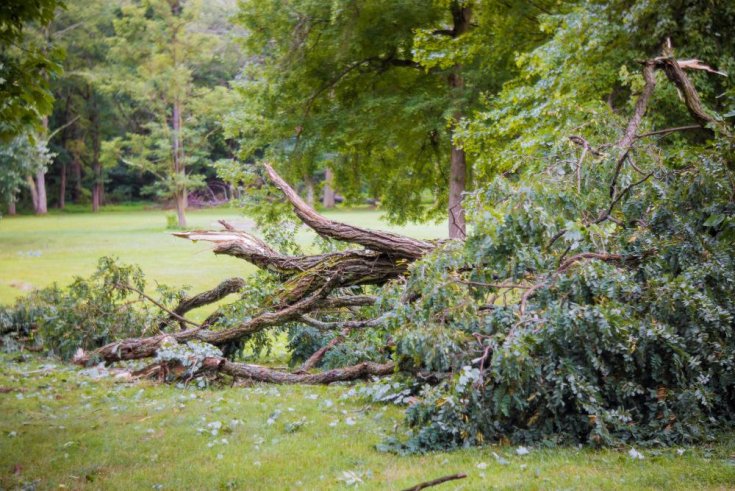Menu
Bagworms are a type of moth larvae that can wreak havoc on trees and shrubs, causing severe damage and premature tree removal projects. Despite their small size and discreet appearance, these pests pose hidden dangers that can harm the health and aesthetics of your property’s greenery. As a property owner, hiring a tree care company for routine inspections can prevent infestation and subsequent repercussions. If you suspect a problem with your trees, the experts at Driscoll Tree Service can help. Let’s look at the various dangers associated with bagworm infestations and the strategies for prevention and control.

The most obvious danger bagworms pose is foliage damage on trees and shrubs. Bagworm larvae feed ravenously on the leaves of host plants, compromising the overall health of the plant. Severe infestations can cause stunted growth, branch dieback, and even tree removal in case of death. Certified arborists can detect signs of deterioration early and recommend effective solutions to prevent extensive damage to foliage.

Besides foliage damage, bagworm infestations can stress and weaken the host plant. As the larvae consume nutrients from the leaves, the tree’s ability to photosynthesize and produce energy is affected. Once the immune system is ultimately compromised, the tree becomes more susceptible to other pests, diseases, and environmental stressors. Stressed plants are less resilient and may struggle to recover from infestations, leading to long-term decline.
Bagworms can lower the aesthetic appeal of trees and shrubs, especially in ornamental landscapes. The presence of unsightly bags hanging from branches and the sight of defoliated foliage can also diminish the beauty and value of your property. We recommend routine tree trimming and pruning of infested trees and shrubs to enhance plant health and the overall esthetic of your landscape. A reputable tree care company can employ effective control measures, maintaining the aesthetic integrity of your outdoor space.
Another hidden danger of bagworms is their potential to spread to other plants within the landscape. Adult female bagworm moths can disperse over considerable distances, laying eggs on various host plants as they search for suitable sites. This can cause infestations throughout the landscape, affecting multiple trees and shrubs. Routine inspections and maintenance by a tree service expert can contain the spread of bagworms, ensuring minor signs of pest damage are addressed.
Beyond the immediate threats to plant health and aesthetics, bagworm infestations can also incur economic costs for property owners. The expenses associated with treating and controlling infestations, including the purchase of insecticides, hiring professional tree service providers, and replacing damaged plants, can add up quickly. Also, the long-term effect of reduced property value and diminished curb appeal can add to the financial burden of bagworm infestations. Investing in preventive measures like routine tree pruning and early intervention can help mitigate these economic costs.
Bagworms may go undetected at first, but their presence can have long-term consequences for the health, appearance, and value of your landscape. Contact us at Driscoll Tree Service and talk to our arborists about the hidden dangers of bagworm infestations for effective prevention and control measures. We provide comprehensive services, including tree pruning, fertilization, removal, and tree trimming, preserving the beauty and vitality of your outdoor spaces.

Essential Tree Care Tips for Every Season Trees require regular care and maintenance to thrive. However, different seasons call for specific care to prevent irreversible damage and premature tree removal emergencies. With that in mind, hiring a professional tree care…
Read More
Just like your car needs regular oil changes and tune-ups, your trees also require routine trimming to keep them healthy and enhance safety. Trimming trees may not be your kind of ideal weekend activity, but it helps to keep your…
Read More
Controlling Tree Pests and Diseases Without Harming the Environment Maintaining healthy trees often entails controlling pests and diseases. With all the different ways homeowners can protect their yards, some cause more environmental damage in the long run. It is advisable…
Read More
Understanding Root Rot Treatment for Trees Roots are vital for the growth and overall well-being of trees. Since roots spread throughout your backyard, it's difficult to detect signs of damage. A common culprit to look out for is root rot,…
Read More
Signs a Tree Might Fall Many property owners appreciate and love their trees but must notice the potential danger some trees present. Research shows that many tree-related accidents could be avoided if people knew the signs and symptoms of a…
Read More
Can a Tree Grow Back from a Stump? When a tree is cut down, many assume that’s the end of its life. However, nature has a remarkable way of surprising us. Under the right conditions, a tree can grow back,…
Read More
Factors to Consider When Choosing a Tree Service Company Maintaining the health and aesthetics of your trees is crucial for the safety and beauty of your property. Whether it’s pruning, trimming, or tree removal, choosing the exemplary tree service can…
Read More
Guide to Tree Removal Insurance When a tree falls in the forest, it is nobody’s problem. However, the repercussions can be dire if a tree falls on your property. Storms and strong winds often cause tree-related damage, especially if the…
Read More
Who is Responsible for a Fallen Tree? Healthy and well-cared-for trees can be a valuable asset to your property, enhancing its beauty and value. However, the natural world can sometimes be unpredictable, and when a tree or large branch falls,…
Read More
How to Prune Fruit Trees Trees are an excellent addition to any landscape. We get a lot of benefits from trees, especially fruit trees. Every homeowner with an orchard wants to enjoy the fruits from their trees, but first, it…
Read More